Did you know that nearly 30% of all online purchases are returned? In the retail landscape, returns are often viewed as a setback. However, with a strategic approach, these returned items can be transformed into a source of revenue recovery. This blog delves into innovative ways to convert the challenge of returns into profitable opportunities.
The Hidden Opportunity in Returns
Every returned item is a potential opportunity. Rather than seeing returns as a loss, forward-thinking businesses recognize them as a chance to enhance customer satisfaction and recover value. The secret lies in creative handling and strategic repurposing of these items.
Inspection, Grading, and Reselling
An effective strategy for maximizing profits from returned merchandise is the inspection and grading process. This approach involves thoroughly inspecting returned items to assess their quality and functionality. If necessary, items are repackaged to meet resale standards. The key step is to grade each product based on its current condition, which then informs the pricing strategy. Products that pass quality and functionality tests are priced accordingly, ensuring they align with their value and condition. This method not only aids in recovering the value of returned products but also appeals to customers seeking quality items at reasonable prices. Additionally, it promotes a sustainable approach to retail by minimizing waste and supporting a circular economy.
Bulk Sales to Liquidators
For businesses dealing with high volumes of returns, selling these items in bulk to liquidators or discount retailers can be a practical solution. This method allows for the efficient handling of large quantities of returns, quickly freeing up storage space and capital. While the return per item might be lower, the overall recovery from bulk sales can be substantial, making it a viable option for managing excess inventory. Establishing relationships with liquidators can be a straightforward process, often involving a few key contacts and agreements on pricing and logistics.
Leveraging Returns for Market Research and Product Development
Instead of the traditional donation route, another innovative strategy is to use returned items as a tool for market research and product development. Analyzing these items can provide insights into why they were returned, such as issues with quality, design, or customer expectations. This information is invaluable for improving existing products and guiding the development of new ones. By addressing the root causes of returns, you not only enhance your product offerings but also potentially reduce the volume of future returns. This approach not only strengthens your product line but also demonstrates to your customers that you are committed to continuous improvement and customer satisfaction.
Conclusion
Returns, often perceived as an unavoidable downside of retail, can actually be a source of opportunity if managed with innovative strategies. By embracing these approaches, businesses can not only recover lost revenue but also strengthen customer relationships and enhance their brand reputation. Are you ready to rethink your returns strategy and turn challenges into opportunities for growth? Begin your revenue recovery journey by contacting us!

